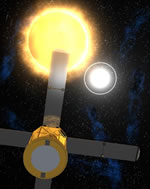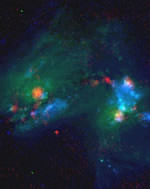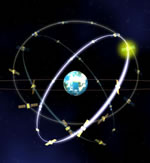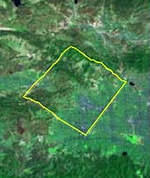
Image credit: NASA
NASA’s RHESSI satellite may have uncovered new clues about the most powerful explosions in the Universe when it accidentally caught an image of a gamma-ray burst while capturing images of solar flares on the Sun. What RHESSI discovered is that the light coming from the burst is polarized, which indicates that a powerful magnetic field could be the cause. When a giant star becomes a rapidly spinning black hole, it could twist up the magnetic field so much that the whole object explodes like an uncoiled spring.
NASA’s RHESSI satellite may have uncovered one of the most important clues yet obtained on the mechanism for producing gamma-ray bursts, the most powerful explosions in the universe. This was the result of a chance observation by a satellite designed to study the Sun.
The Reuven Ramaty High-Energy Solar Spectroscopic Imager (RHESSI) satellite was snapping pictures of solar flares on December 6, 2002, when it caught an extremely bright gamma-ray burst in the background, over the edge of the Sun, revealing for the first time that the gamma rays in such a burst are polarized. The result indicates intense magnetic fields may be the driving force behind these awesome explosions.
Solar flares are tremendous explosions in the atmosphere of the Sun, powered by the sudden release of magnetic energy. Gamma-ray bursts are remote flashes of gamma-ray light that pop off about once a day randomly in the sky, briefly shining as bright as a million trillion suns. Recent observations suggest they may be produced by a special kind of exploding star (supernova), but not all supernovae generate gamma-ray bursts, so the physics of how a supernova explosion can produce a burst of gamma-rays is unclear.
The findings are being presented in a press conference at the American Astronomical Society meeting in Nashville, Tenn., by two University of California, Berkeley, researchers: Dr. Wayne Coburn, a postdoctoral fellow at UC Berkeley’s Space Sciences Laboratory, and Dr. Steven Boggs, assistant professor of physics. They are authors of a paper about this discovery published in the May 22 issue of Nature.
“RHESSI was sent into space to uncover the secrets of solar flares, the largest explosions in our Solar System, so I am delighted that it has been able to serendipitously provide new information about gamma-ray bursts, the largest explosions in the whole universe,” said Dr. Brian Dennis, RHESSI Mission Scientist at NASA’s Goddard Space Flight Center, Greenbelt, Md.
“Curiously, magnetic fields seem to be driving both the local solar flares and the distant gamma-ray bursts, two immensely powerful events,” added Dennis.
The strong polarization measured by RHESSI provides a unique window on how these bursts are powered, according to Boggs. He interprets the measurements to mean that the burst originates from a region of highly structured magnetic fields, stronger than the fields at the surface of a neutron star – until now, the strongest magnetic fields observed in the universe. “The polarization is telling us that the magnetic fields themselves are acting as the dynamite, driving the explosive fireball we see as a gamma-ray burst,” he said.
The gamma rays measured by RHESSI were about 80 percent polarized, consistent with the maximum possible polarization from electrons spiraling around magnetic field lines. The spiraling causes electrons to produce light by “synchrotron radiation”. Polarized light, familiar to most of us as the reflected light blocked by Polaroid sunglasses, is light with its magnetic and electric fields vibrating primarily in one direction, not randomly. Such coherence implies an underlying physical symmetry, in this case, aligned magnetic fields.
Though the electrons are probably accelerated to nearly the speed of light in shock waves, the fact that the gamma rays are maximally polarized implies that the shock waves themselves are driven by an underlying strong magnetic field.
“The amount of polarization they found is so intense, that it looks like it’s pure synchrotron radiation and nothing else, and all the other theories are going to have to bite the dust now,” said Dr. Kevin Hurley, a UC Berkeley gamma-ray burst physicist who since 1990 has operated the Third Interplanetary Network (IPN3) of six satellites linked together to pinpoint gamma-ray bursts and immediately alert astronomers. However, for such a novel measurement, further independent confirmation is crucial, Boggs added.
The discovery of polarization reveals how a gamma-ray burst is powered – through the generation of a strong, large-scale magnetic field. The next question is: Why do some supernovae lead to a strong, organized magnetic field? This might be a question we can only address through theory, but the pieces of evidence are in place for theorists to unravel, Boggs said.
Though he leaves it to theorists to work out how such strong magnetic fields could be generated, Boggs said that the burst is probably preceded by the core collapse of a massive star directly to a black hole. A black hole itself has no magnetic field, but the local magnetic field can thread through the black hole. If rapidly spinning, the black hole will wind up the local field like a string on a top. The energy density in the tightly wound, compressed field would eventually get so high that the field would rebound outward in a massive fireball, dragging matter with it.
Original Source: NASA News Release



